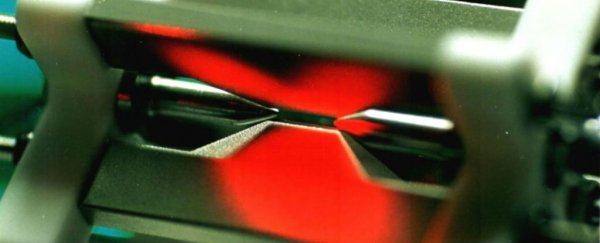In physics experiments, one of the telltale signs that what you're looking at is true quantum behaviour is if certain numbers - known as quantum bounds - turn up in your calculations.
Just like Pi is likely to turn up in your equations when a circle's involved, quantum bounds such as 4, 6, and 2√2 are used by physicists as an indication for when they've left the realm of classical physics to enter the quantum world. But now a new study suggests that there's nothing exclusively 'quantum' about them at all.
Let's back up a little here, because this is pretty tricky unless you're familiar with what's actually going on. First off, we've got classical physics versus quantum mechanics.
Classical physics encompasses all the work done in the areas of chemistry and physics prior to the 20th century, including the classification of the periodic table, thermodynamics, the wave theory of light, and Newtonian mechanics. Basically, if you can easily observe something, you can probably use the laws of classical physics to explain it.
Quantum mechanics, on the other hand, is only fairly new, and seeks to explain the strange and seemingly random behaviour of photons, electrons, and other very tiny particles that make up the Universe.
In physics, the smaller you go, the weirder things get, and quantum mechanics is there to help you make sense of it all.
As the University of California, Davis website explains, "Objects that are a 'normal' size (larger than a molecule and smaller than a planet), at a 'normal' temperature (anywhere close to room temperature), going a 'normal' speed (0 m/s - anything significantly less than the speed of light) fit the models set forth in classical mechanics."
But once the system you're trying to observe starts to go beyond these parameters, you might have to resort to quantum mechanics, which was "born out of the inability of classical mechanics to reconcile theory with experiment", says UC Davies.
One of the most fundamental differences between the two is that quantum mechanics allows for correlations and interactions between certain particles that are nowhere near each other, and classical physics absolutely does not.
An example of this is quantum entanglement - a strange phenomenon where two quantum particles interact in such a way that they become deeply linked, and essentially 'share' an existence. This means that what happens to one particle will directly and instantly affect what happens to the other - even if that other particle is many light-years away.
Einstein himself struggled with this idea, famously deriding it as "spooky action at a distance", and it's now become the key to what could be the next generation of computers.
Quantum bounds are supposed to act as a signal to physicists that what's going on in their experiment can only be explained by the laws of quantum mechanics, but a new study by physicists in Spain has shown that they might not be as exclusively 'quantum' as we'd assumed.
To demonstrate this, the team from the University of Sevilla performed three different experiments that use quantum bounds to distinguish between quantum and classical phenomena.
As Lisa Zyga reports for Phys.org, these experiments are designed to show whether or not a system can violate what's known as a quantum inequality. The greater the violation, the more quantum the system, and the maximum violation is defined as the quantum bound.
"The quantum bounds arise from probability distributions in the experiments, and are specific numbers - for instance, the Bell inequality has a quantum bound of 2√2 (approximately 2.82), which is known as Tsirelson's bound," says Zyga. "The other two inequalities addressed here have quantum bounds of 4 and 6. Both theoretically and experimentally, no violation of a quantum inequality has ever surpassed these bounds."
The Sevilla team's three experiments involved firing microwaves down a metre-long transmission line, and calculating the probabilities of their behaviour at the end based on both classical assumptions and violations of the quantum inequalities.
They found that the classical experiments resulted in bounds of 2.78, 3.93, and 5.93, all of which actually 'beat' the quantum experiments' results in terms of how close they'd gotten to the quantum bounds of 4, 6, and 2√2 (2.82), "providing strong evidence that both quantum and classical experiments produce the same bounds," says Zyga.
So… what now? The results will need to be replicated in many more experiments until we can know for sure that quantum bounds are actually fairly ineffective signals of quantum behaviour, but if they are, it could actually help scientists in their quest to build the world's first proper quantum computer.
One difference between the two experiments was that the classical experiments required more energy to achieve these bounds than the quantum experiments, which is a bummer for efficiency, but we know a whole lot more about building computers based on classical physics than quantum physics, so maybe there's room to combine the two.
"In contrast to quantum systems, which are very sensitive to the environment, the wires in our experiment can be bent, moved, heated, etc., and the results are the same," one of the team, Diego Frustaglia, told Phys.org. "This suggests a future in which quantum technologies are actually built using quantum systems plus classical systems imitating quantum systems."
We've said it once, and we'll say it again, but there's never been a better time to be a physicist.
The study has been published in Physical Review Letters, and can be accessed freely at arXiv.org.
